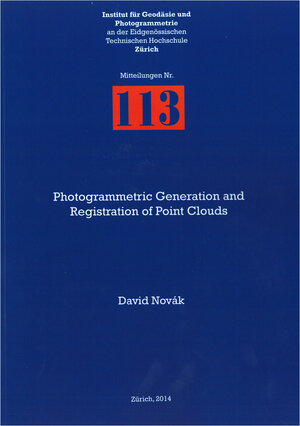
×
![Buchcover ISBN 9783906467993]()
Photogrammetric Generation and Registration of Point Clouds
von David NovákThis dissertation addresses the problems of generating point clouds from images (imagebased modelling) and registering these with laser scanner point clouds. Currently, the former is solved in a fully automated fashion by measuring tie points between images, orienting them, and then performing dense matching. The latter is also fully automated, or semi-automated by first obtaining rough approximations of the registration parameters and then refining them by minimizing the distance between all corresponding points detected in the process.
The problem with image-based modelling is that it rarely offers manual interaction possibilities, such as manual definition of bundle adjustment iterations or convergence criteria, and the results rarely offer statistical output. Furthermore, convergent image networks are difficult for automated measurement methods, such as SIFT with nearest neighbour matching, to process. The point cloud registration suffers from the problem that very few algorithms can solve scale differences between the point clouds. Because the point clouds from imagebased modelling can have very large differences in scale, compared to point clouds from active sensors, it is a problem that has been rarely addressed.
This dissertation is focused on investigating these problems. The primary goal is to achieve accurate point clouds from images and register these with laser scans in a fully automated approach. The image-based modelling is very similar to existing work flows but uses a novel tie point measuring algorithm to drastically reduce mismatches and increase robustness. Additionally, its results have full statistical output. The point cloud registration presents a unique approach to registering point clouds by using a 2.5D representation, eliminating the scale difference between the point clouds.
The results for the image-based modelling work flow show both highly robust and accurate adjustment results, as well as dense point clouds with great detail. The point cloud registration achieves a high percentage of correct registrations with a large number of different data sets. The experiments for both parts are conducted with multiple data sets with very different characteristics and show promising performance for the proposed methods.
The problem with image-based modelling is that it rarely offers manual interaction possibilities, such as manual definition of bundle adjustment iterations or convergence criteria, and the results rarely offer statistical output. Furthermore, convergent image networks are difficult for automated measurement methods, such as SIFT with nearest neighbour matching, to process. The point cloud registration suffers from the problem that very few algorithms can solve scale differences between the point clouds. Because the point clouds from imagebased modelling can have very large differences in scale, compared to point clouds from active sensors, it is a problem that has been rarely addressed.
This dissertation is focused on investigating these problems. The primary goal is to achieve accurate point clouds from images and register these with laser scans in a fully automated approach. The image-based modelling is very similar to existing work flows but uses a novel tie point measuring algorithm to drastically reduce mismatches and increase robustness. Additionally, its results have full statistical output. The point cloud registration presents a unique approach to registering point clouds by using a 2.5D representation, eliminating the scale difference between the point clouds.
The results for the image-based modelling work flow show both highly robust and accurate adjustment results, as well as dense point clouds with great detail. The point cloud registration achieves a high percentage of correct registrations with a large number of different data sets. The experiments for both parts are conducted with multiple data sets with very different characteristics and show promising performance for the proposed methods.


